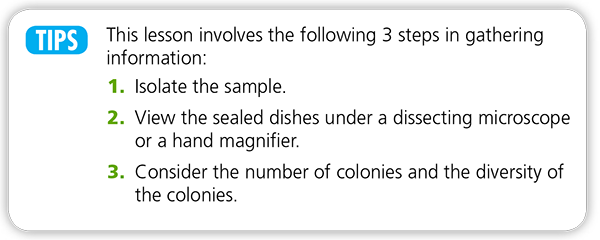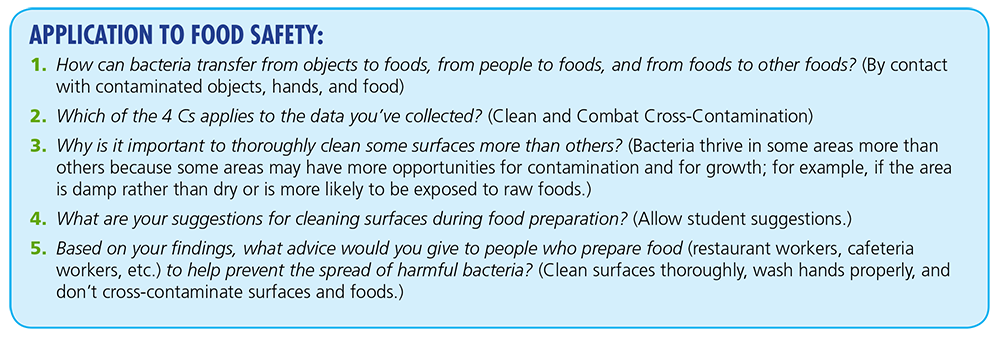Food safety is everyone’s responsibility — everyone involved in growing, processing, transporting, and handling our food along all the points in our complex food production and distribution system. This responsibility includes all of us as we purchase, prepare, and eat our food. Students need to understand that food safety is a very serious issue that affects the well-being of every individual. So, because everyone must eat, we’re all at risk of becoming ill if food becomes contaminated.
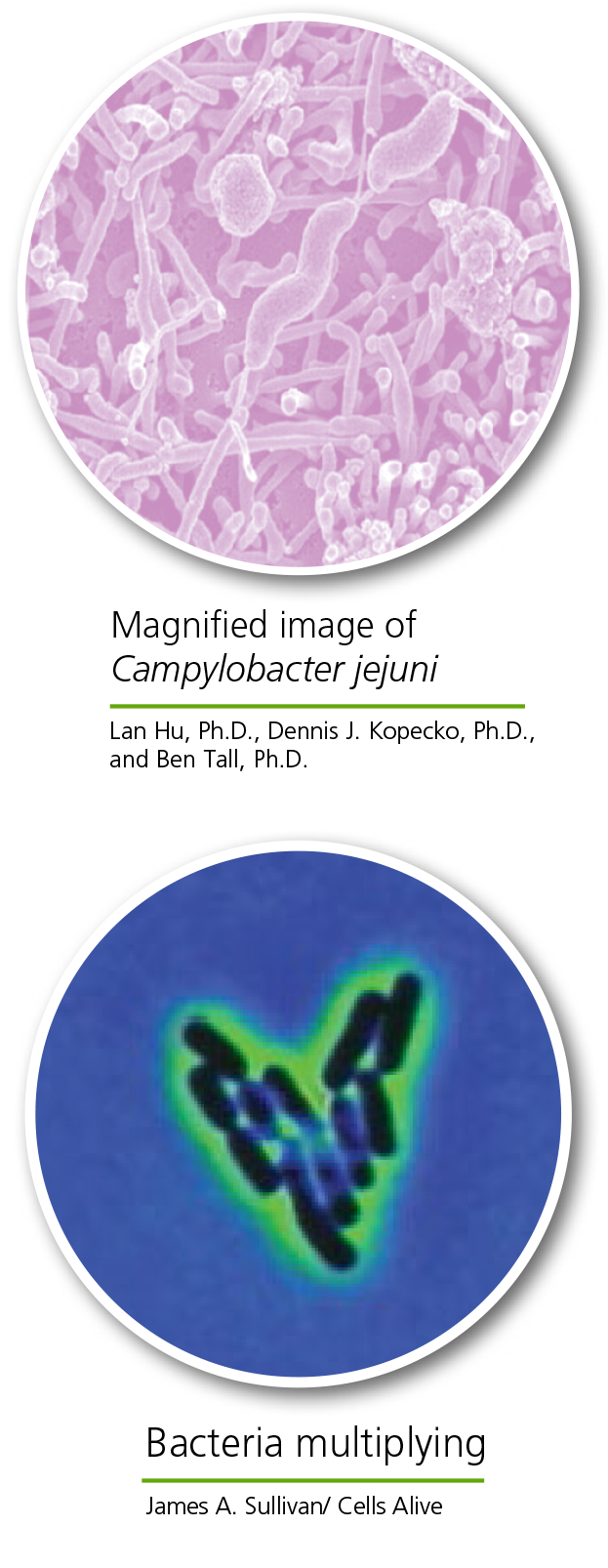
Food Safety and the Battle with Bacteria
The United States has one of the safest food supplies in the world, but there’s always room for improvement. The battle to prevent foodborne illness is waged every day because bacteria are everywhere. Food safety has to do with controlling bacteria. And since everyone eats, we all share the responsibility for keeping our food free from harmful bacteria.
Electron Microscope
An electron microscope uses electrons instead of visible light to produce magnified images. It can magnify bacteria a million times their normal size.
Where Bacteria Come From and How They Grow
Bacteria are found everywhere, and under the right conditions, they can multiply fast! Each bacterium contains all the genetic information needed to make copies of itself. Bacteria multiply through binary fission, a process in which the cell’s DNA doubles, the cell splits, and two independent cells are formed. Under the right conditions, a single bacterium will double with each division — 2 become 4, 4 become 8, etc. A single cell can turn into millions of cells in a few hours and billions of cells within one day!
This rapid growth is not usually a problem with good bacteria; however, when it occurs with “bad” bacteria (a.k.a. pathogens), it is “bad” news. As pathogens multiply, some give off harmful toxins or become infectious. If pathogens get into our food and multiply, people can get sick.
The 12 Most Unwanted Bacteria
- Campylobacter jejuni
- Clostridium botulinum
- Clostridium perfringens
- Escherichia coli O157:H7
- Listeria monocytogenes
- Salmonella Enteritidis
- Salmonella Typhimurium
- Shigella
- Staphylococcus aureus
- Vibrio cholerae
- Vibrio vulnificus
- Yersinia enterocolitica
Required Conditions for Bacterial Growth
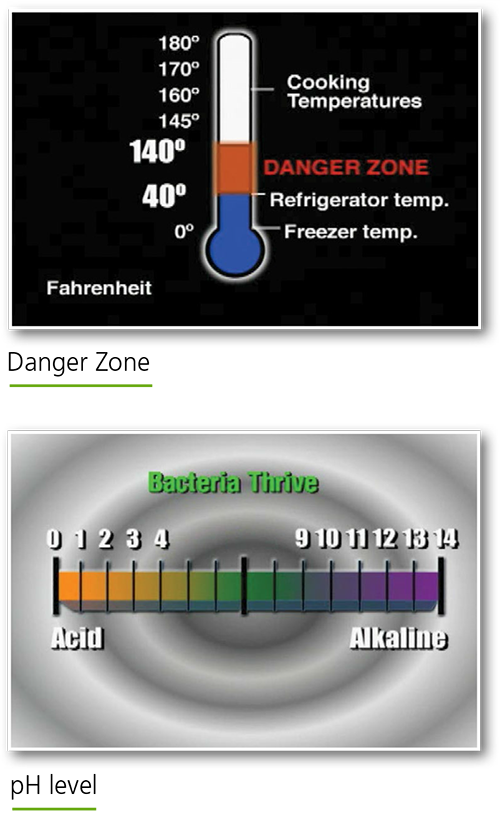 Time/Temperature — Under the right conditions, some bacteria can double their numbers within minutes and form toxins that cause illness within hours. To minimize bacterial growth in foods, it’s important to keep food temperatures below 40° F (4° C) or above 140° F (60° C). The level in between this temperature range is known as the Danger Zone.
Time/Temperature — Under the right conditions, some bacteria can double their numbers within minutes and form toxins that cause illness within hours. To minimize bacterial growth in foods, it’s important to keep food temperatures below 40° F (4° C) or above 140° F (60° C). The level in between this temperature range is known as the Danger Zone.- Nutrients — Bacteria need many of the same nutrients as humans in order to thrive (glucose, amino acids, and some vitamins and minerals). For example, bacteria grow rapidly in high-protein foods such as meat, poultry, eggs, dairy, and seafood.
- pH — Microorganisms thrive in a pH range above 4.6. That’s why acidic foods like vinegar and citrus juices are not favorable foods for pathogenic bacteria to grow; however, they may survive in these foods.
- Moisture — Most bacteria thrive in moist environments; they don’t grow on dry foods. That’s why dry foods like cereals can safely sit out at room temperature.
- Note: If dry foods like dry cereals or spices become contaminated from infected hands or equipment, bacteria can survive on the food and make people sick, but they can’t grow or multiply until the food is consumed.
How the 4 Cs of Food Safety Control Bacteria
If bacteria can grow so rapidly under the right conditions, then how do we control them? It’s simple:
- Cleaning — removes bacteria from hands and surfaces.
- Cooking — kills bacteria by breaking down their cell walls and destroying enzymes, which they need to survive.
- Chilling — slows down the bacteria’s metabolism, thus slowing their growth.
- Combating Cross-Contamination (separating foods) — prevents bacteria from spreading from one food item to another, or between foods and hands or surfaces/utensils.

Emerging Pathogens
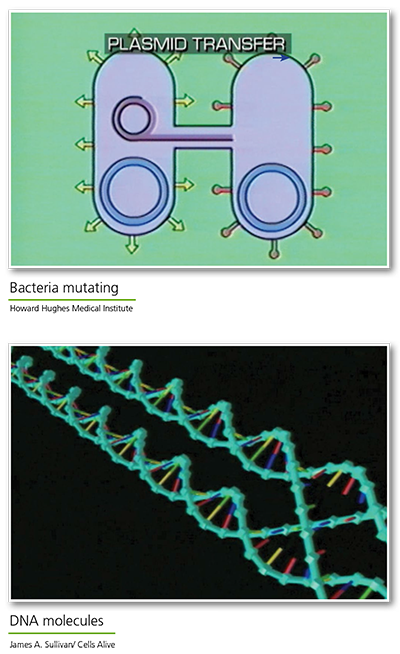
Not only can bacteria multiply quickly, but they can also mutate (adapt and evolve), a process that results in changes to their genetic code. These changes happen very slowly and can make the bacteria better able to survive. These changes can also change harmless bacteria into harmful bacteria, which often possess a new genetic characteristic like antibiotic resistance.
How Scientists Can Tell Good Bacteria from Harmful Bacteria
DNA (deoxyribonucleic acid) is the “genetic blueprint” for all living things. A DNA molecule looks like a double helix that’s shaped like a long ladder twisted into a spiral. The ends are joined to form a continuous loop, like a rubber band.
DNA contains the information that gives living organisms their traits or characteristics. In people, it determines traits like physical features, behaviors, and even whether we’re right or left-handed. In bacteria, the DNA molecule encodes the information that enables bacteria to grow, reproduce, and cause illness.
Scientists use DNA “fingerprinting” to identify similar groups of bacteria. DNA is treated so that it exhibits its own special pattern. When there is an outbreak of foodborne illness, epidemiologists (scientists who track down the causes of diseases and find ways to control them) try to determine the source of bacteria in foods by examining the pathogen’s DNA “fingerprint.” Then they see if it matches up to “fingerprints” (patterns) from other samples.
Food Safety Connection
Food safety is everyone’s responsibility — everyone involved in growing, processing, transporting, and handling our food along all the points in our complex food production and distribution system. This responsibility includes all of us as we purchase, prepare, and eat our food. Students need to understand that food safety is a very serious issue that affects the well-being of every individual. So, because everyone must eat, we’re all at risk of becoming ill if food becomes contaminated.
Science and our Food Supply Modules
This lesson was developed as a portion of an entire unit of lessons focusing on food safety from farm to table. Use the following links to see the remaining lessons:
Module 1: Bacteria
Module 2: Farm
Module 3: Processing and Transportation
Module 4: Retail and Home
Module 5: Outbreak and Future Technology
Evaluation

 Time/Temperature — Under the right conditions, some bacteria can double their numbers within minutes and form toxins that cause illness within hours. To minimize bacterial growth in foods, it’s important to keep food temperatures below 40° F (4° C) or above 140° F (60° C). The level in between this temperature range is known as the Danger Zone.
Time/Temperature — Under the right conditions, some bacteria can double their numbers within minutes and form toxins that cause illness within hours. To minimize bacterial growth in foods, it’s important to keep food temperatures below 40° F (4° C) or above 140° F (60° C). The level in between this temperature range is known as the Danger Zone.


